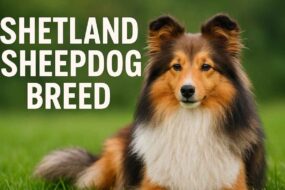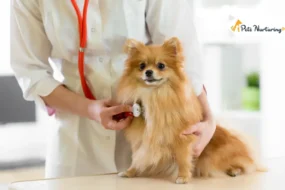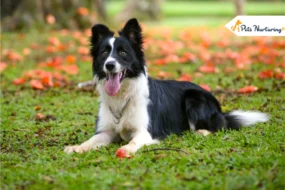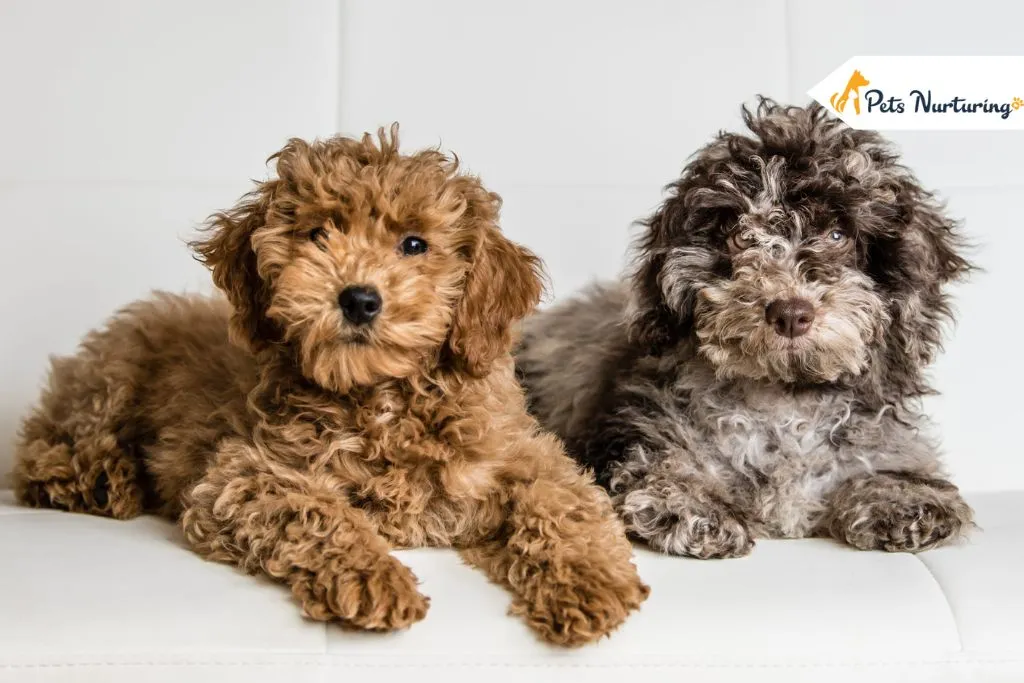
A dog with a teddy bear face, soft curly fur, and an endearing personality, can you guess this dog breed name?
Yes, we’re talking about the cutest and cuddly breed, Mini Goldendoodle!
From Instagram, Pinterest to every online platform, these adorable puppies can be seen everywhere.
If you’re looking for a playful, active, and fluffy companion, a mini Goldendoodle is the best choice!
Want to know more about this charming dog breed? If yes, keep reading.
Today in this blog, we’re going to tell you all about the Mini Goldendoodle dog. From their history, characteristics to temperament, and health problems, we have covered everything in detail.
- History of Mini Goldendoodle
- Types of Mini Goldendoodles
- Size & Appearance of Mini Goldenpoo
- Temperament and Personality of Miniature Goldendoodle
- Exercise and Training Need of Mini Goldendoodle
- Food and Diet Need of Mini Goldendoodle
- Health and Nutritional Needs of Mini Goldendoodle
- Grooming Needs of Mini Groodle
- Common Health Problems in Mini Groodles
- Are Mini Goldendoodles Hypoallergenic?
- Lifespan of Mini Goldendoodles
- Interesting Facts about Mini Goldendoodle
Mini Goldendoodle Dog Breed Overview
Breed Name: Goldendoodle
Breed Group: Hybrid Group
Height: 13 to 30 Inches
Weight: 15 to 45 Pounds
Lifespan: 12 to 15 years
Coat: Flat, Straight, Wavy or Curly
Color: Black, Gray, Red, Blue, Cream, White, Fawn, Gold / Yellow, Brown / Chocolate / Liver
Temperament: Energetic and Friendly
Needs for Grooming: Moderate
Hypoallergenic: Yes (Mostly)
Origin: Australia & United States
History of Mini Goldendoodle
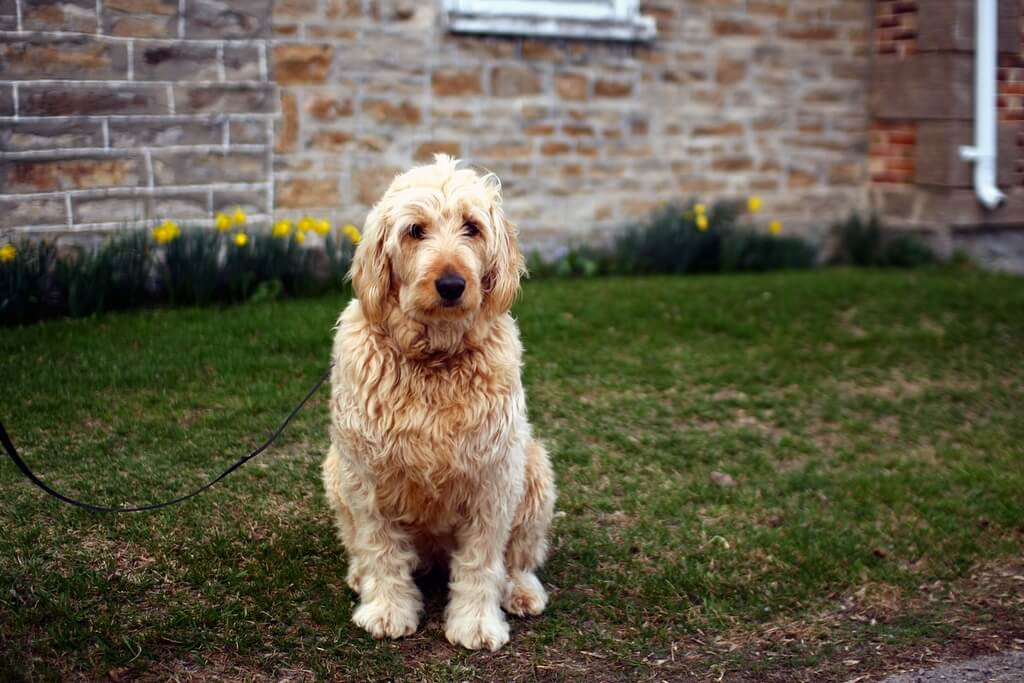
Mini Goldendoodles are the miniature version of the Goldendoodle dog breed. It is not a pure breed dog but rather a cross between two different breeds. This is why they are also known as designer dogs.
They are a mix between the Toy or Miniature Poodle and a Golden Retriever. Mini Goldendoodles have been around for decades since they first appeared in the 1960s. Breeders wanted to create a dog breed with the hypoallergenic qualities of the Poodle and the loving and loyal nature of Golden Retrievers, which resulted in a magic combo – Mini Goldendoodle.
The popularity of these dogs began surfacing around the late 1990s and early 2000s. They have origins in Australia and the United States. Initially, breeders bred only the Standard version of the toy Poodle with Golden Retrievers but later started experimenting with the Toy and Miniature versions. This is how Mini Goldendoodles came into existence.
These dogs have now become very popular due to their low shedding coat, pleasing temperament, intelligence, cute and adorable looks and social nature. They are an ideal breed for families.
Origin of Poodles
Poodles originated from Germany and were used mostly as hunting dogs. However, they became very popular in France, where they were bred in three different sizes. As of now, Poodles are the number one choice when it comes to cross-breeding. They are used to create many designer dogs like Labradoodle, Cockapoo, Cavapoo, etc.
Origin of Golden Retriever
Golden Retrievers have origins in Scotland around the 19th Century. They were bred by a nobleman named Lord Tweedmouth, who wanted to create a dog that could hunt and retrieve as well as sport loyalty and devotion. This is why Golden Retrievers are such loyal companion dogs that can help you with chores.
Types of Mini Goldendoodles
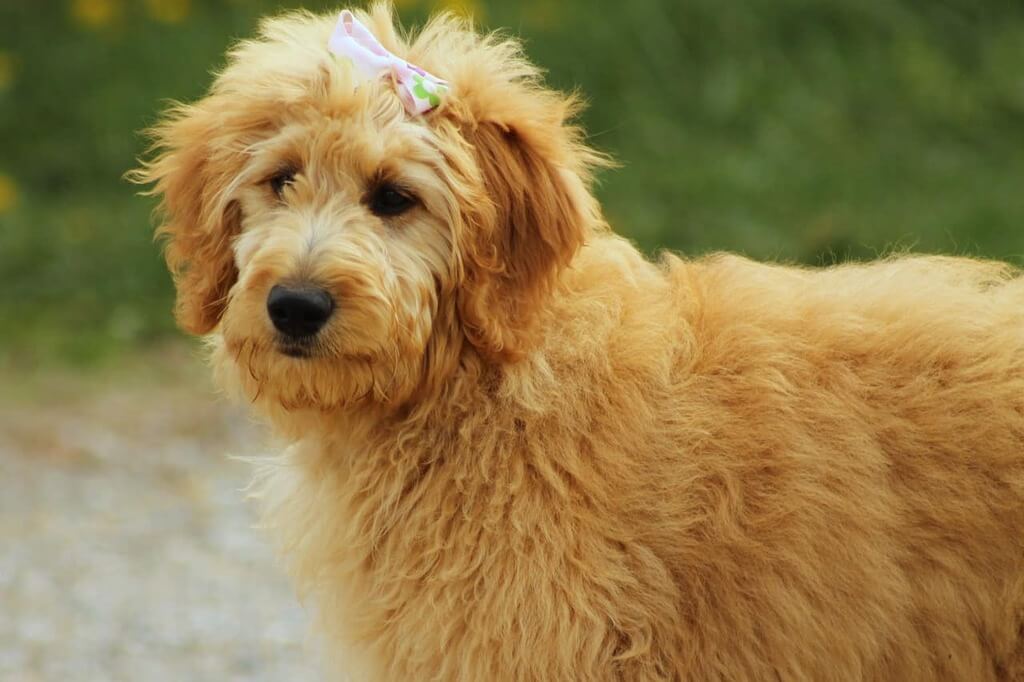
Mini Goldendoodles are available in various generations. Here are four different generations:
1. F1 Mini Goldendoodle
An F1 Mini Goldendoodle is the result of breeding a purebred Miniature or Toy Poodle with a purebred Golden Retriever.
This generation typically has a 50% Poodle and 50% Golden Retriever genetic makeup.
Since F1 Mini Goldendoodles get characteristics from both parent breeds, they can have a variety of coat types and temperaments.
2. F1b Mini Goldendoodle
An F1 Mini Goldendoodle and a purebred Poodle are crossed to produce an F1b Mini Goldendoodle.
Because of its non-shedding coat and increased Poodle gene content, this generation is frequently preferred.
F1b Mini Goldendoodles are frequently a wonderful option for people with allergies because of their curlier coats.
3. F2 Mini Goldendoodle
Two F1 Mini Goldendoodles can be bred to produce an F2 Mini Goldendoodle.
The genetic balance between Golden Retriever and Poodle is preserved in this generation.
Like the F1 generation, F2 Mini Goldendoodles can have a broad variety of coat types and temperaments.
4. F2b Mini Goldendoodle
An F2 Mini Goldendoodle and a purebred Poodle are crossed to create an F2b Mini Goldendoodle.
This generation is known for having more Poodle genes, curlier coats, and hypoallergenic qualities.
F2b Mini Goldendoodles are bred to enhance specific traits and are often chosen for their low-shedding coats
Size & Appearance of Mini Goldenpoo
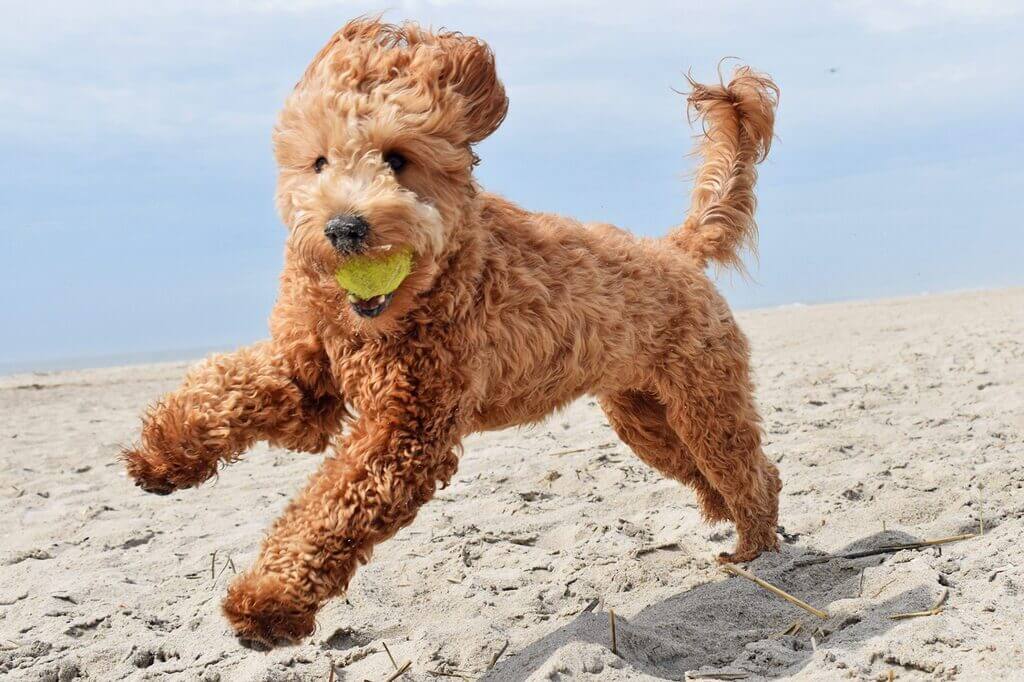
Size (Height and Weight)
Another fascinating thing about this dog breed is that they vary in size. However, compared to Goldendoodles, they are smaller in size as they are bred using a Toy or Miniature version of a Poodle.
They can reach a height between 13 to 30 inches and weigh anywhere from 15 to 45 pounds, depending on the gender and age. Their size typically depends on the size of their Poodle parent. If you need a smaller dog than this breed, a micro mini Goldendoodle is a good choice.
Appearance
When it comes to appearance, Mini Goldendoodles perfectly resemble a teddy bear. They have round skulls, broad muzzles, heavily feathered tails, droopy ears, and attractive oval-shaped eyes. Overall, they’re cute enough to make anyone fall in love with them.
As their parents are retrievers, they also have similarly long and muscular bodies with a deep chest and wide stance. You can find a Goldendoodle in various coats and furs, from light cream color to a rich auburn red. Some puppies also have small white markings on their chest.
Temperament and Personality of Miniature Goldendoodle
Mini Goldendoodles are just like their retriever parents: gentle, friendly, and eager-to-please! Plus, they’re extremely social, playful, and intelligent because they’re also part mini poodles.
Even if you have infants and young kids in your family, you can go for this dog breed because mini Goldendoodle temperament is calm and friendly and they’re naturally inclined to be careful with infants and toddlers. They’ll be perfect and patient companions for children and will develop a strong bond with them.
Thus, they’re an excellent option for families with young children. All you need to do is supervise and teach your kids ‘how to interact with pets properly.’
These adorable dogs are always warm towards people. They also crave a lot of love and attention from their pack. They’re extremely loyal and always want to stay close to their humans!
Apart from a loving and friendly personality, they are also highly social and outgoing. For example, when you take them on walks, they will happily meet and greet other people, thereby becoming a favorite in the neighborhood.
They are also highly energetic and active. These dogs also possess the intelligence of a Poodle and are fun to train. They love exercising and playing different games. So, make sure you dedicate time to take them out and keep them engaged.
Here are some of their personality traits:
- Playful
- Affectionate and loving
- Energetic and loyal companions
- Crave attention and affection
- Highly smart and intelligent
- Sociable and easily bonds with both dogs and cats
- Assertive and outgoing in their approach
- May struggle with extended periods of solitude
- Under stress, they may exhibit signs of separation anxiety
Exercise and Training Need of Mini Goldendoodle
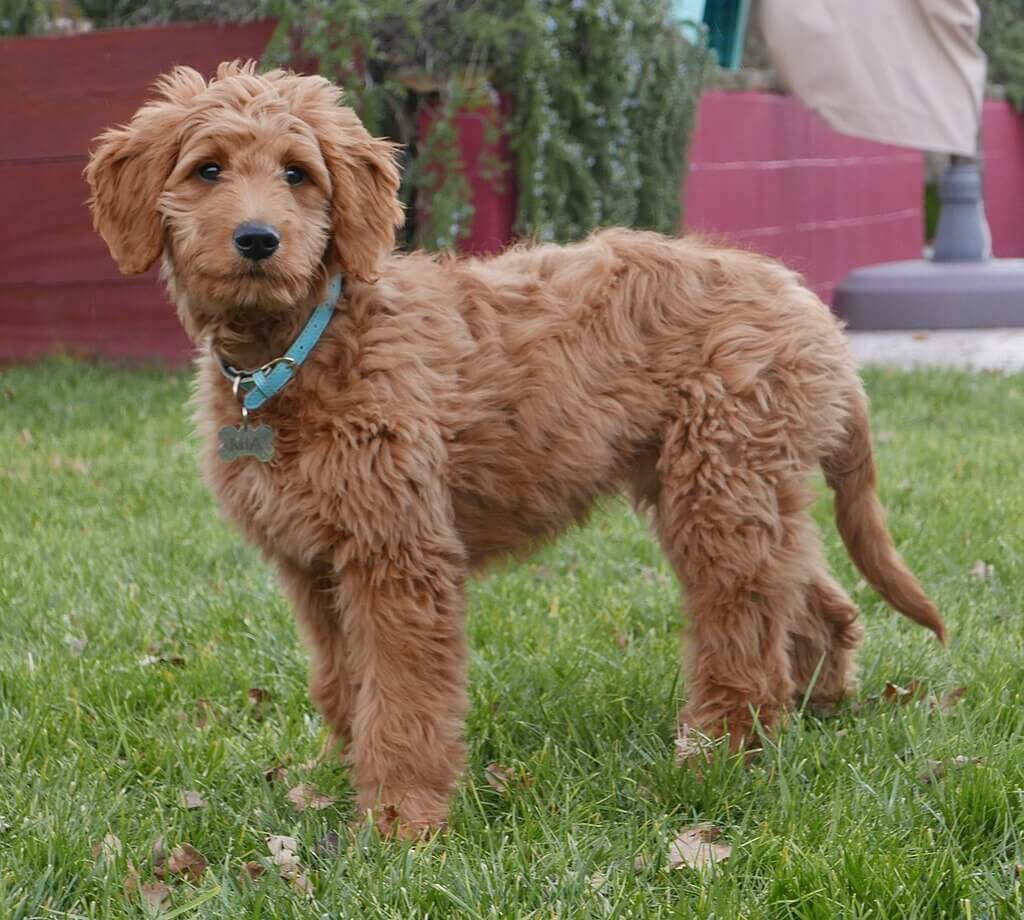
Exercise Needs (45 to 60 Minutes Daily)
Don’t get fooled by their small size; they’re absolutely not a lapdog at all. Yes, even though they’re tiny, they require at least 20 to 30 minutes of exercise twice a day. So, on a daily basis, you need to offer them at least 45 to 60 minutes of physical exercise.
You can play with them and take them to the local parks or doggy pool for water exercises. You can also arrange a play area in your outdoor or backyard space to run and play fetch with them. One thing you have to keep in mind is that this dog breed is energetic, so they can be easily bored. As a solution, you can mix up their daily exercise routine with various types of activities.
Apart from physical exercises, you also need to offer mental stimulation. They are very clever and love to play games. You can buy interactive games for dogs to keep your furry friend’s mind occupied.
Also, make sure to fence your outdoor area as they’re small and can escape from even tiny gaps. Another thing is to provide good shelter from the sun. You should keep them away from sunlight as they have thick and dense curly fur. Especially on hot days, you can play with them indoors or give them a cool water bath.
Training Needs (Easy to Train)
You’ll be happy to know that mini Goldendoodle puppies are very intelligent and super easy to train. They’re always ready to please their owners. Though their concentration levels aren’t the best, they’ll try their best to learn new things. Instead of long training sessions, go for short and sweet ones. Positive reinforcement training, some verbal praise, and small training treats will help them learn things quickly and easily.
Just like any other breed, it’s best to train the mini Goldendoodles dogs as early as possible. If you have a mini puppy, be sure to expose them to as many unfamiliar sounds and sights as you can. This will help them to socialize with their environments and surroundings.
This will also help to build his confidence and become a well-mannered adult doggo. Plus, you can make many memories and strong bonds between you and your puppy during these training sessions. You need to start potty training as well as crate training from a young age.
Food and Diet Need of Mini Goldendoodle
An average mini Goldendoodle full grown dog needs about 30 calories per pound of its body weight for healthy maintenance. Now, you might be thinking that small dog breeds will surely need low calories. However, that’s not true! Small dogs have fast metabolisms, and sometimes, they need more calories than large breeds.
Always try to provide an appropriate diet for dogs that has high concentrations of protein with moderate fat content and limited carbohydrates. According to veterans, “Protein is essential for puppies to grow and develop properly.” A good diet full of proteins will support lean muscle mass and healthy body weight for adult dogs.
Feeding Schedule:
- Puppy (8-12 weeks): 3-4 times a day
- Adult (6 months): 2 meals a day
Apart from food, you also need to provide fresh water to your dog. They should have access to drinking water all the time. The best thing you can do is fill a bowl with water and keep it near the feeding area. Make sure you change the water twice a day. It is necessary to keep them hydrated, especially on summer days.
If you are using treats to train your dog or reward them for good behavior, make sure you choose only the healthier ones. Also, treats should only be 10% of their daily calorie intake. The best thing to do is prepare healthy treats at home to avoid any health issues.
NOTE:
The exact amount of food that you should feed your dog majorly depends on their size, weight, age, build, metabolism, and activity level. So, make sure to know your dog’s food requirements. You can also consult your vet and ask them to make a complete diet plan specifically for your dog.
Health and Nutritional Needs of Mini Goldendoodle
Like all dogs, optimum health and nutrition are essential for Mini Goldendoodles. Here are some key considerations:
1. High-Quality Diet
You need to feed a balanced diet to your dog. It is best to invest in high-quality dog food that contains all the essential nutrients, minerals and vitamins. Avoid using foods with excessive fillers and additives.
2. Portion Control
As the dogs are smaller in size, portion control is necessary. If you feed them more food, they can develop conditions like obesity and joint problems. Make sure you follow the recommended feeding guidelines as per their weight, age and physical activity.
3. Vet Checkups
You also need to take your Mini Goldendoodle for regular vet checkups. These visits will help you detect any health problems at an early stage and keep your dog in the best health possible.
4. Avoid Toxic Food
Human food is not safe for dogs, so remember to avoid feeding leftovers to your dog. Grapes, chocolate, garlic, and onions are some of the most toxic foods for dogs. Make sure you avoid these foods.
Grooming Needs of Mini Groodle
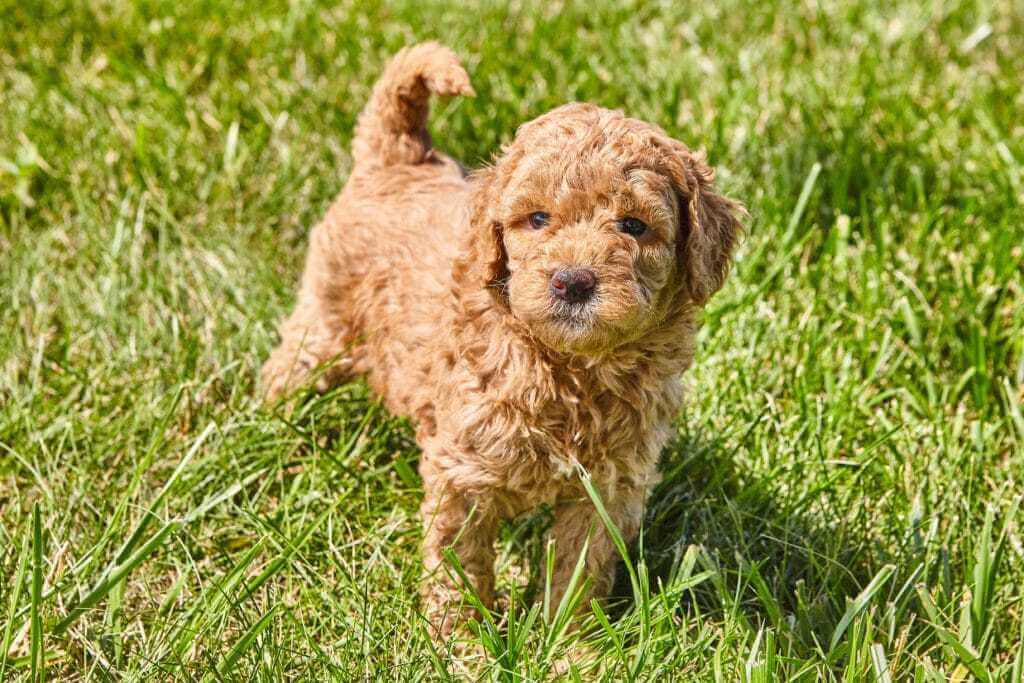
Mini Goldendoodles don’t shed as much as double-coated dogs, but it’s extremely important to groom them from time to time. As we already told you, they have a curly coat, so they can easily mat if not appropriately maintained.
These puppies don’t need regular brushing; however, you should brush their coat at least once or twice a week. Apart from this, if your dog loves to play outside, he’ll also need regular baths.
Most of the mini doodle owners opt for an easy-to-care-for cut. You can also consult your local groomer, as they can recommend the best look for your dog. That will look adorable on your pup and also easy to maintain.
You also need to clean their ears to avoid infections. Moreover, make sure you trim their nails and clean their paws when they return from walks. Lastly, brush their teeth regularly to avoid any dental problems.
Common Health Problems in Mini Groodles
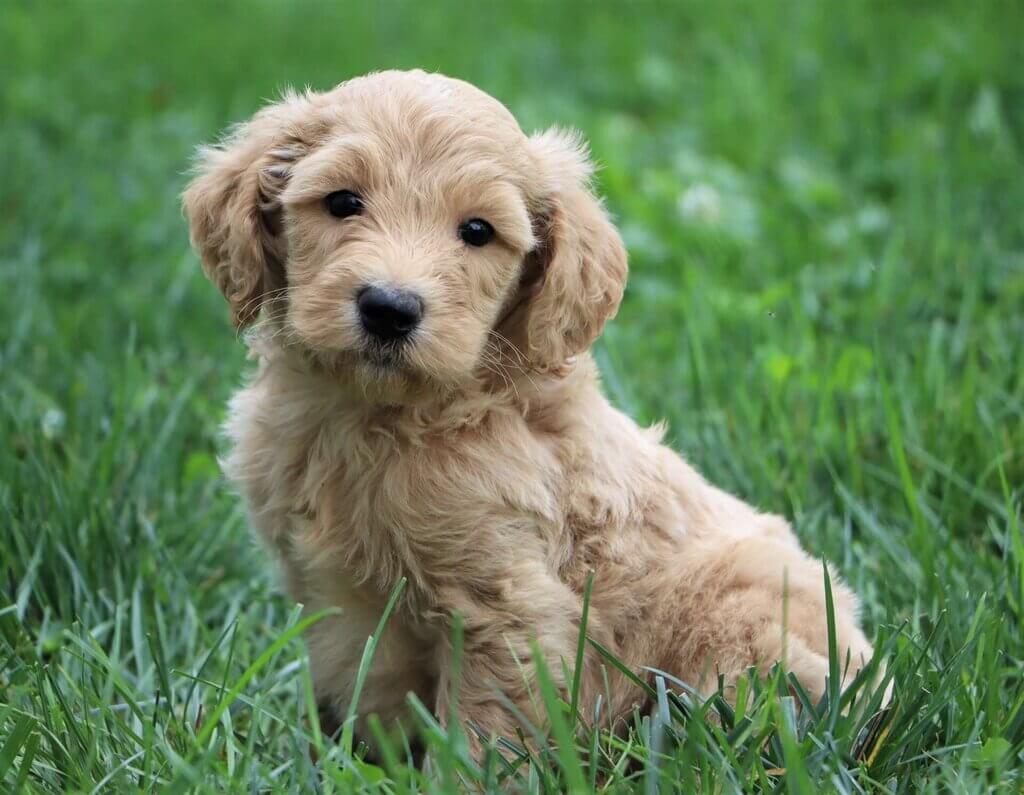
Health problems can occasionally be inherited by Goldendoodles from their Golden Retriever and Poodle ancestry. It is advisable to schedule routine veterinary visits and educate yourself on how to avoid these issues.
Note that not every Mini Goldendoodle will experience these problems; in fact, some can be treated with medication, dietary supplements, and proper care.
These are a few typical health issues that Mini Goldendoodles may experience:
Hip Dysplasia
This occurs when there is pain at the hip joint due to poor fit. Pain can be avoided with routine veterinary care and joint supplements like glucosamine and omega-3 oils.
Patella Luxation
This is a condition where improperly developed joints cause pain when walking. You may avoid this by feeding your dog a healthy diet and maintaining a healthy weight.
Progressive Retinal Atrophy (PRA)
Golden Retrievers can pass on PRA, which causes gradual eye deterioration, leading to night blindness and daytime vision loss. Regular vet checkups are vital to catch this early.
Von Willebrand’s Disease (VWD)
VWD is a bleeding disorder, not hemophilia, resulting from a lack of clotting protein. It’s hereditary and affects both humans and dogs. Although there’s no cure, well-cared-for Mini Goldendoodles can manage the condition with proper care.
Here are some other health conditions that are common in Mini Goldendoodles:
- Cataracts
- Hypothyroidism
- Addison’s disease
- Ear infections
- Allergies
NOTE:
Mini Goldendoodles have many health problems; that’s why it is important to check the parent’s health and genetic clearances while you’re picking the breeder. There are many tests available in the market from which breeders can easily check if the parents of a pup are likely to pass conditions onto their offspring or not.
Are Mini Goldendoodles Hypoallergenic?
Mini Goldendoodles are often considered hypoallergenic. This means they are less likely to trigger allergies in people. Their curly or wavy coats produce fewer allergenic particles like dander and hair.
However, no dog is entirely hypoallergenic, as it depends on individual sensitivities. Regular grooming and keeping their living space clean can help reduce allergens and make it easier for allergy-prone people to enjoy the company of Mini Goldendoodles.
Lifespan of Mini Goldendoodles
Mini Goldendoodles typically have a lifespan of about 12 to 15 years. However, how long they live can be influenced by factors like their diet, exercise, genetics, and overall health, both physically and mentally.
Interesting Facts about Mini Goldendoodle

After reading here, you might be thinking that you know everything about the mini Goldendoodle. However, that’s not all. Below are some fascinating facts about this breed:
- Miniature Goldendoodles are not officially registered, but still, they’re considered a “designer breed.”
- These dogs are extremely friendly and have gentle natures; that’s why they’re excellent service and therapy dogs.
- Mini doodles are great for sniffing and guide dogs, but they’re not suitable as a watchdog.
- This breed is hypoallergenic. These dogs are easy to clean and maintain and hence make perfect for owners with allergies.
- Goldendoodles are available in three types of coats: straight, wavy, and curly.
FAQs
Goldendoodles don’t shed much compared to other dog breeds because of their curly and wavy coat.
A mini Goldendoodle is a good dog as they are loyal, loving, affectionate and easy to train.
Yes, mini doodles are mostly hypoallergenic because they produce less dander.
This dog breed is often prone to health issues like hip dysplasia, cataracts, patella luxations and von Willebrand’s disease.
Mini Goldendoodle for sale can be anywhere around $2000 to $4000.
Final Words :
So this is all about the famous mini Goldendoodle breed. If you’re planning to get a Miniature Goldendoodle puppy, make sure to do in-depth research and get all the necessary information. Check through rescues and shelters or buy from breeders. Remember to check their health certificates. This way, you’ll be able to get a healthy and happy puppy!
We hope this in-depth Mini Goldendoodle dog breed guide has helped you decide if this breed is the right choice for you.
For more information:








